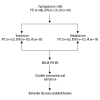Detection and Identification of Serum Peptides Biomarker in Papillary Thyroid Cancer
- PMID: 29549708
- PMCID: PMC5870111
- DOI: 10.12659/msm.907768
Detection and Identification of Serum Peptides Biomarker in Papillary Thyroid Cancer
Abstract
BACKGROUND Papillary thyroid cancer (PTC) is currently the most commonly diagnosed endocrine malignancy. In addition, the sex- and age-adjusted incidence of PTC has exhibited a greater increase over the last 2 decades than in many other malignancies. Thus, discovering noninvasive specific serum biomarker to distinguish PTC from cancer-free controls in its early stages remains an important goal. MATERIAL AND METHODS Serum samples from 88 PTC patients and 80 cancer-free controls were randomly allocated into training or validation sets. Serum peptide profiling was performed by matrix-assisted laser desorption/ionization-time of flight mass spectrometry (MALDI-TOF-MS) after using weak cation exchange magnetic beads (WCX-MB), and the results were evaluated by use of ClinProTools™ Software. To distinguish PTC from cancer-free controls, quick classifier (QC), supervised neural network (SNN), and genetic algorithm (GA) models were established. The models were blindly validated to verify their diagnostic capabilities. The most discriminative peaks were subsequently identified with a nano-liquid chromatography-electrospray ionization-tandem mass spectrometry system. RESULTS Six peptide ions were identified as the most discriminative peaks between the PTC and cancer-free control samples. The QC model exhibited satisfactory sensitivity and specificity among the 3 models that were validated. Two peaks, at m/z 2671.17 and m/z 1464.68, were identified as fragments of the alpha chain of fibrinogen, while a peak at m/z 1738.92 was a fragment of complement component 4A/B. CONCLUSIONS MS combined with ClinProTools™ software was able to detect peptide biomarkers in PTC patients. In addition, the constructed classification models provided a serum peptidome pattern for distinguishing PTC from cancer-free controls. Both fibrinogen a and complement C4A/B were identified as potential markers for diagnosis of PTC.
Figures



Similar articles
-
Application Value of Mass Spectrometry in the Differentiation of Benign and Malignant Liver Tumors.Med Sci Monit. 2017 Apr 4;23:1636-1644. doi: 10.12659/msm.901064. Med Sci Monit. 2017. PMID: 28376075 Free PMC article.
-
Discovery and identification of potential biomarkers of papillary thyroid carcinoma.Mol Cancer. 2009 Sep 28;8:79. doi: 10.1186/1476-4598-8-79. Mol Cancer. 2009. PMID: 19785722 Free PMC article.
-
Serum peptide profiling for potential biomarkers in early diagnosis of Escherichia coli bloodstream infection.Cytokine. 2019 Aug;120:71-77. doi: 10.1016/j.cyto.2019.04.010. Epub 2019 Apr 23. Cytokine. 2019. PMID: 31026733
-
VHL tumor suppressor as a novel potential candidate biomarker in papillary thyroid carcinoma.Biomol Biomed. 2023 Feb 1;23(1):26-36. doi: 10.17305/bjbms.2022.7850. Biomol Biomed. 2023. PMID: 36036061 Free PMC article. Review.
-
The Importance of miRNA in the Diagnosis and Prognosis of Papillary Thyroid Cancer.J Clin Med. 2021 Oct 15;10(20):4738. doi: 10.3390/jcm10204738. J Clin Med. 2021. PMID: 34682861 Free PMC article. Review.
Cited by
-
Early diagnosis of colorectal cancer via plasma proteomic analysis of CRC and advanced adenomatous polyp.Gastroenterol Hepatol Bed Bench. 2019 Fall;12(4):328-339. Gastroenterol Hepatol Bed Bench. 2019. PMID: 31749922 Free PMC article.
-
Integrated analysis of circulating and tissue proteomes reveals that fibronectin 1 is a potential biomarker in papillary thyroid cancer.BMC Cancer. 2023 May 8;23(1):412. doi: 10.1186/s12885-023-10839-w. BMC Cancer. 2023. PMID: 37158852 Free PMC article.
-
In search of new stratification strategies: tissue proteomic profiling of papillary thyroid microcarcinoma in patients with localized disease and lateral neck metastases.J Cancer Res Clin Oncol. 2023 Dec;149(19):17405-17417. doi: 10.1007/s00432-023-05452-0. Epub 2023 Oct 20. J Cancer Res Clin Oncol. 2023. PMID: 37861757 Free PMC article.
-
The Blood Biomarkers of Thyroid Cancer.Cancer Manag Res. 2020 Jul 6;12:5431-5438. doi: 10.2147/CMAR.S261170. eCollection 2020. Cancer Manag Res. 2020. PMID: 32753960 Free PMC article. Review.
-
MALDI-TOF-MS Analysis in the Identification of Urine Proteomic Patterns of Gestational Trophoblastic Disease.Metabolites. 2019 Feb 9;9(2):30. doi: 10.3390/metabo9020030. Metabolites. 2019. PMID: 30744112 Free PMC article.
References
-
- SEER Cancer Statistics Review, 1975–2014. http://seer.cancer.gov/statfacts/html/thyro.html.
-
- Chen AY, Jemal A, Ward EM. Increasing incidence of differentiated thyroid cancer in the United States, 1988–2005. Cancer. 2009;115:3801–7. - PubMed
-
- Wang Y, Wang W. Increasing incidence of thyroid cancer in Shanghai, China, 1983–2007. Asia Pacific J Public Health. 2015;27:NP223–29. - PubMed
-
- Hundahl SA, Cady B, Cunningham MP, et al. Initial results from a prospective cohort study of 5583 cases of thyroid carcinoma treated in the United States during 1996. Cancer. 2000;89:202–17. - PubMed
MeSH terms
Substances
LinkOut - more resources
Full Text Sources
Medical
Miscellaneous

